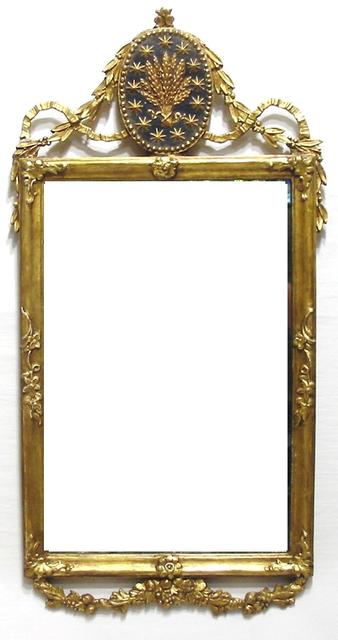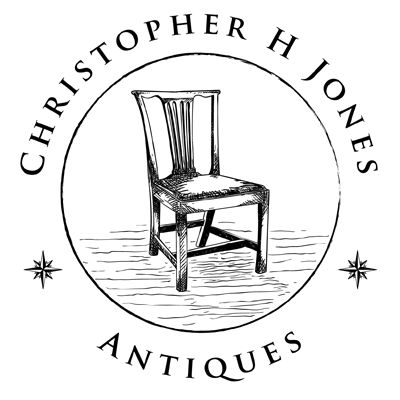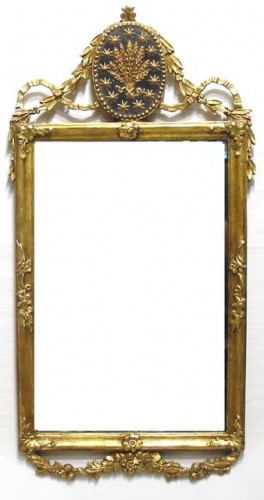 Dimensions: Width 15″ Height 30″
Dimensions: Width 15″ Height 30″
Maker: unknown
Origin: probably Boston, possibly Newport, R.I. or Europe
Date: circa 1790
Commentary: The design of this gilt looking glass reflects Americans’ rapid, although belated, acceptance of the neoclassical taste in the years following the Revolutionary War and was inspired by examples in Hepplewhite’s Cabinet-Maker and Upholsterer’s Guide. The dark blue oval shield with 13 gold stars in combination with golden sheaves of wheat is an unusual, though not unique compositional element, which adds considerably to the appeal of this object. It may have been purchased separately by the artisan who incorporated it into his overall design.
As David Barquist noted in American Looking Glasses In the NeoClassical Style 1780-1815 (Magazine Antiques, February 1992), it was standard practice for makers of looking glasses to acquire various elements from merchants such as John Doggett of Roxbury, Mass. or John McElwee of Philadelphia, who advertised in 1800 that he sold a Quantity of Composition Ornaments and Moulds of every pattern necessary for the Looking Glass business. Similar shields and other design features can be seen on looking glasses illustrated by Wallace Nutting from the collection of James Fennimore Cooper and by Edgar Miller from his personal collection in his American Antique Furniture.
A looking glass in the collection of the Department of State attributed to Constant Bailey, who worked in the Goddard and Townsend shop in Newport, displays a virtually identical crest atop an albeit significantly different mahogany and gilded frame. Sack designates as an example of the “best” a similar looking glass, with the notable difference that the crest on this glass features a profile bust of George Washington.
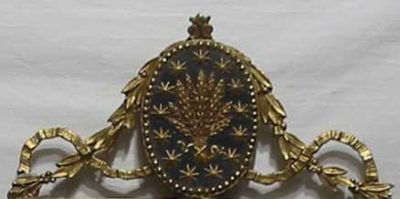
This looking glass was originally among the belongings of John Hay who, according to the inscription of the frame’s verso, “at the time of Bunker Hill lived in the first frame house in Charlstown (sic) Mass.” In his history of Charlestown, James Hunnewell describes a wooden house built by John Hay near Thompson Square as “among the most notable landmarks in the central parts of Charlestown.” The Hay family had extensive land holdings in and around Charlestown which, at John Hay’s death in 1802, passed principally to his son William (d.1813) and daughter Mercy Boylston (d.1849). This looking glass apparently descended in the Hay family Boston to Charles Chauncy Hay (1882- ?) who sold it to Maryland antique dealers John C. and Frances Ann Stokes, during the period that their antique shop was located at Hampton National Historic Site. (circa 1952-1980) as was recorded on the attached label.
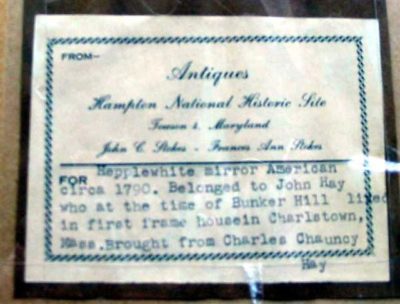
Definitive attribution of most looking glasses to an American or European source is hazardous. Virtually all of the glass in looking glasses found in American homes prior to the Civil War and the majority of the frame components of looking glasses made prior to 1800 were of European origin. Similarly, because many American merchants affixed their own labels to imported furniture, when labels have survived they offer little in the way of “proof” of the pieces’ origins. Since large quantities of American woods were exported to Europe to be used in the manufacture of furniture, much of which was then re-exported to the United States, wood analysis is of only limited assistance but it can provide important clues. Microscopic analysis reveals the presence of basswood in the carved elements of the frame of the Hay Family looking glass. Since basswood was commonly found and used in New England by furniture craftsmen, this looking glass might well be American in origin. Basswood, however, also grows in the northern regions of Europe and is known in European furniture.
The construction of the frame and joining of the crest, ribboning and hanging hook appear to be the work of a small shop with limited experience in incorporating multiple elements in a finished piece rather than the work of a Continental shop accustomed to larger scale production for export. The combination of family history, wood, distinctively American decorative elements, carving and construction suggest that this is an early example of a neoclassical looking glass by an American artisan, probably working in Boston.
Condition: Elements of the frame’s applied ornamentation and its surface have been conserved by Gold Leaf Studios, Washington, DC, under the supervision of William Adair. The crest retains the majority of its original surface although it was necessary to remove several layers of later finishes from substantial areas of the carved ribbons, swags, rosettes and molding surfaces. Some repairs were made to the gesso or “compo” ornamentation due to chipping or to compensate for old repairs. The surviving wood carved areas required little conservation. Based on other similar, period looking glasses, it is possible that an additional ornamental element such as an eagle originally adorned the frame’s crest but has now been lost.
Price: SOLD

